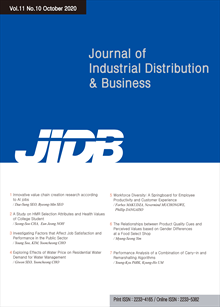간행물
산경연구논집 (JIDB) KCI 등재 산경연구논집 The Journal of Industrial Distribution & Business (JIDB)

- 발행기관 한국유통과학회
- 자료유형 학술지
- 간기 월간
- ISSN 2233-4165 (Print)2233-5382 (Online)
- 수록기간 2010 ~ 2020
- 주제분류 사회과학 > 경영학 사회과학 분류의 다른 간행물
- 십진분류KDC 325DDC 330
권호리스트/논문검색
Vol. 11 No. 11 (2020년 11월) 4건
1.
2020.11
서비스 종료(열람 제한)
2.
2020.11
서비스 종료(열람 제한)
Purpose: The supply of and demand for medical services continue to increase as the current social environment changes. Consequently, competition among medical institutions is intensifying and hospitals must establish appropriate management strategies to improve the medical services they provide. This study suggests that the authenticity of doctors is a factor in improving medical-service quality and examines the effect authenticity has on the affective trust and satisfaction of patients. Design, methodology, and approach: The study utilized previous studies to examine the significance of potential variables, established hypotheses and used a questionnaire to confirm these hypotheses. The questionnaire was distributed to patients who had visited a hospital in the previous six months. Responses were analyzed empirically using structural equation modeling. Findings: The analysis found that a physician’s authenticity has a significant impact on the affective trust of patients. While patients’ affective trust does not have a similar strong impact on patient satisfaction, physician authenticity does have a significant impact on patient satisfaction. Conclusion and implications: This study examined the roles of authenticity, affective trust, and patient satisfaction in doctor-patient relationships in the medical services field. The implication of the findings is that physician authenticity is a prerequisite for patient satisfaction of medical services.
3.
2020.11
서비스 종료(열람 제한)
Purpose: The problem of housing poverty among young people is a very important problem for the nation. Therefore, the main purpose of this paper is to identify the problems of the government's housing support policy for young people. And it is in presenting specific solutions by fully reflecting the opinions of experts. Research design, data and methodology: This study consisted of analyzing the following three research topics: 1) the differences of youth residential support housing policy impact on young adults’ housing stability, 2) the problems and solutions of youth housing support policy, and 3) the differences of experts' opinions on the impact of government policy on youth housing stability. The subject of this study is the government's seven housing policies for young people. The targets include Happy Public Rental Housing (Happiness Housing), Station Area Rental Housing for youth (Station Area 2030), Public Dormitory for College Students (Public Dormitory & Hope Dormitory), Jeonse Rental Housing for College Students (Subject Lease Rental Housing for College Students), Social Housing for Young People, and Share House. The data was organized through expert surveys from 1st to 30th June 2020. The experts surveyed include professors & researchers, public officer & public institutions staff, and private developers of young adults’ housing. The methodology of analysis on the problem and the solution of government policy was Frequency analysis. And analysis methods on differences of experts’ opinion were ANOVA, Levene’ test, and Schefe test. Results: Problems in Government's youth residential support housing policy include high rents, lack of supply, difficulty in acquiring rental housing, inconvenience in using shared spaces, conflicts with cohabitants, and invasion of privacy. Solutions include expanding supply to urban areas, establishing long-term plans, securing privacy, diversifying business methods, establishing platforms for rental housing transactions, and expanding various public support (financial support, etc). Conclusions: There was a difference in perception among groups of experts on the impact of public rental housing (called ‘happiness housing’) in youth housing stability. It is very urgent to come up with the most reasonable policy to support youth housing. This requires in-depth discussions by experts to narrow their differences.
4.
2020.11
서비스 종료(열람 제한)
Purpose: With a rapid advance of communication technology, distributional systems of sport contents continue to show improvements. In particular, a traditional framework in creating sport cartoon has been influenced by the environment of the communication industry. Despite the development of distributional systems, the current sport cartoon industry still lacks in advancement. To this day, various research about sport contents have been conducted; yet, not many studies of the interaction between sport cartoons and communication technology have been done. In this respect, this study is to review the distributional environment of the sport cartoon industry and provide distributional strategies for developing sport cartoon industry. Research design, data, and methodology: In addition to indepth interviews with five practitioners in sport cartoon industry, the study employed case study methodology. Interview data were analyzed by qualitative content analysis. Results: With new environments allowing anyone allowing to create and share webtoons, various genres including sports webtoons appear, and this became a motive to the growth of sports webtoons. Today, sports comics acted as a sports advertisement platform which not only created additional profit but also became an opportunity as a marketing method. On the contrary, the formal attributes of webtoons cause hardship in consistently creating sports webtoons. Hence, it is needed that supporting policies need to be established to nurture sport webtoon expertise. For example, Korea Creative Content Agency allows future webtoon authors to have an opportunity to be educated and equipped in producing creative sport webtoon contents. Moreover, revenue systems should be developed for motivating webtoon authors to involve in sport contents in their works. Conclusions: In order to promote the sports cartoon industry based on the findings, it is first necessary to create sports comics that reflect the formal characteristics of webtoons and the changing consumer environment. Second, it is important to acknowledge the industrial value of sports comics and it is necessary to promote policies regarding sports webtoon production and distribution from a national level. Third, by diversifying profits through OSMU and sports advertisements, it is possible to enhance the work environment and the treatment of authors. Implications and future directions were discussed.

